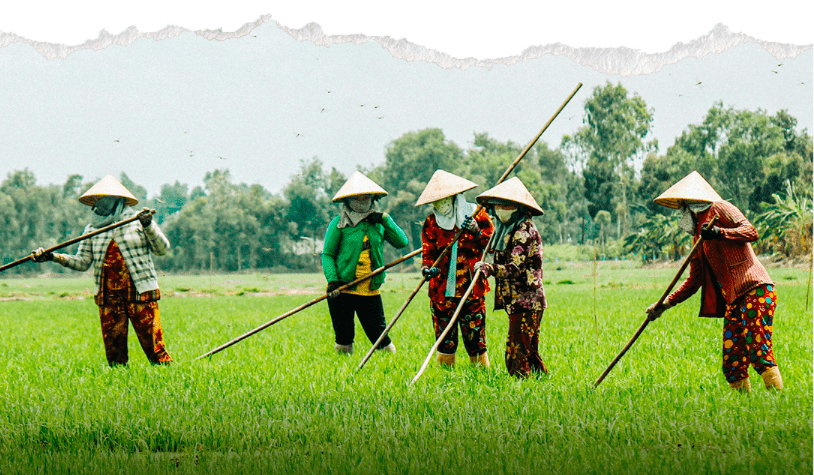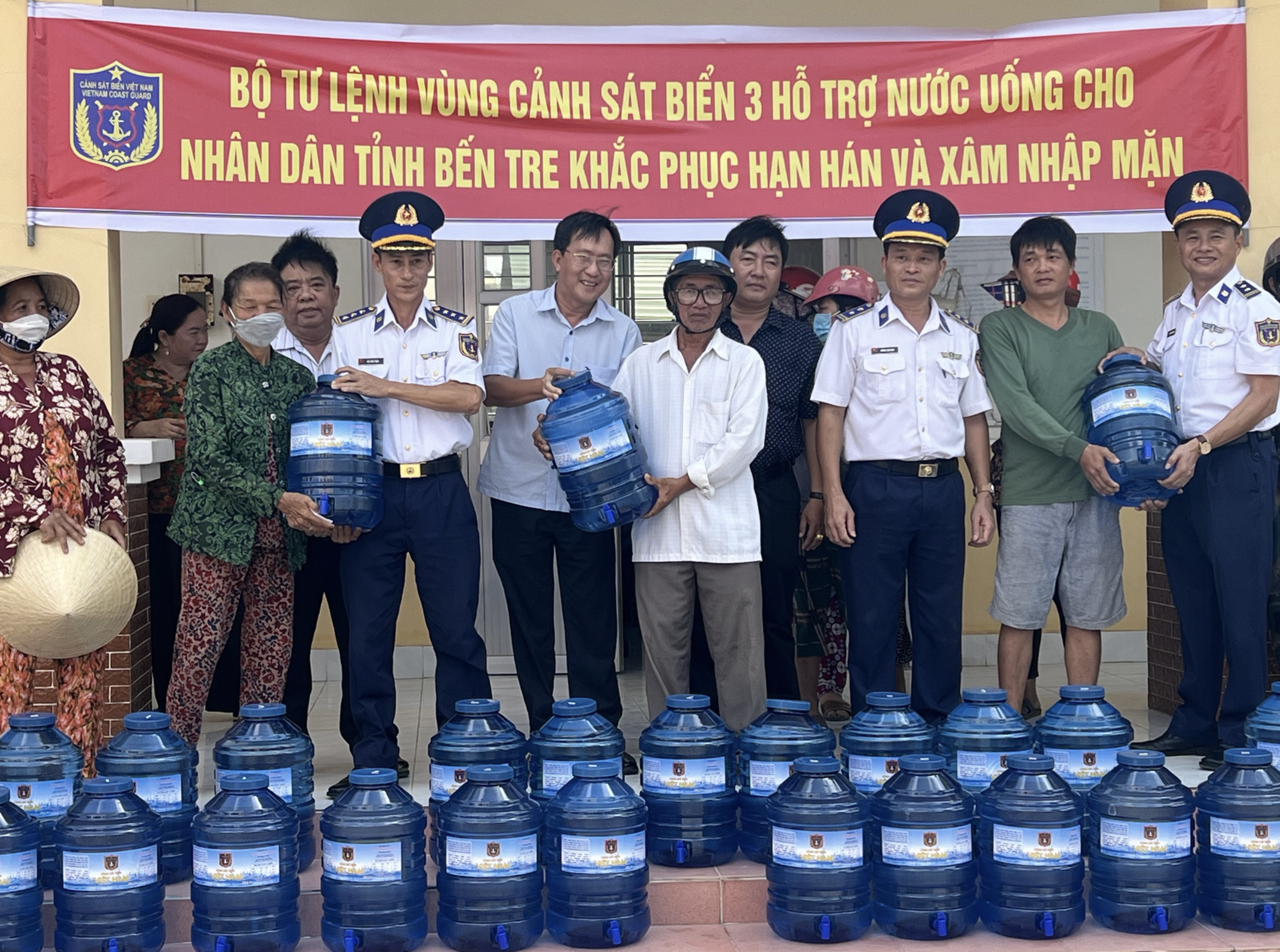Rice, prawn, catfish and fruits – four spearheads of the Mekong Delta economic zone – have not only made momentous changes to the lives of local people but also reflected the profound transformation of Vietnam’s southwestern region.
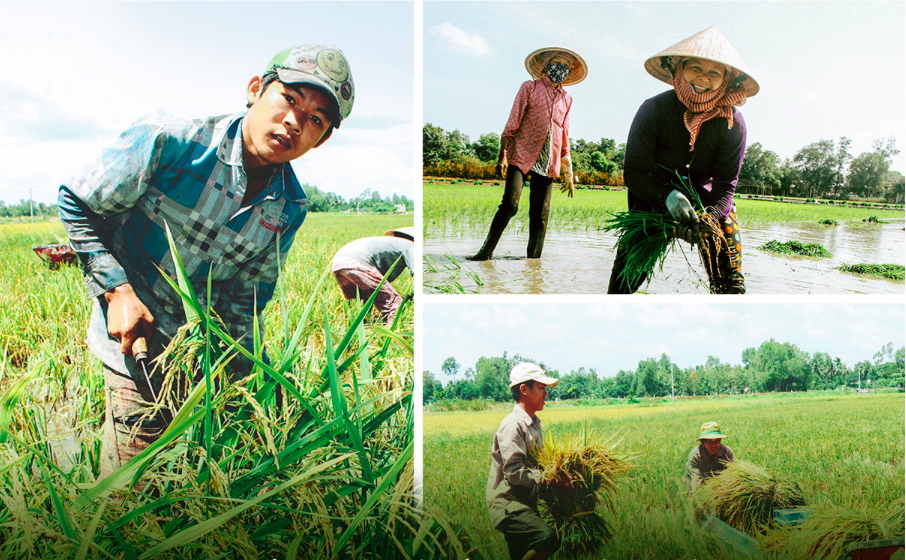 |
| Harvesting rice by hand in the Mekong Delta. Photo: Chi Quoc/Tuoi Tre |
Upgrading Vietnamese rice to the world’s level
It was the last day of 2020 when Ho Van Cua – a farmer entitled the “Hero of Labor” – leisurely roamed around and adored his paddy field in Soc Trang Province – home of world-renowned rice types, namely ST24 and ST25. Cua was completing his report for the prestigious 6th Ho Chi Minh Award.
“Hundred years ago, the land was famous for its delicious rice which was exported to Europe. However, in ten years after the country’s reunification, rice farmers worked for a sole target – to raise productivity,” said Cua.
In 1975, Mekong Delta’s rice farming area was just two million hectares, including 1.5 million hectares for single crops. Traditional rice types were still sensitive to changing weather conditions and vulnerable to pests. To cope with saline intrusion, reclamation, irrigation and soil improvement were prioritized for investments.
Amid the 80s “rice rush” when farmers nationwide hustled to raise productivity, Cua – an officer of the My Xuyen District Agriculture Department back then – also found himself roaming from one paddy field to another.
“At the time, I thought of having my own rice seeds. The development was obviously not an overnight matter. Therefore, I switched to improve popular rice types used in the Mekong Delta which originated from Thailand to make them much more resilient to local weather conditions and offer high productivity,” he said.
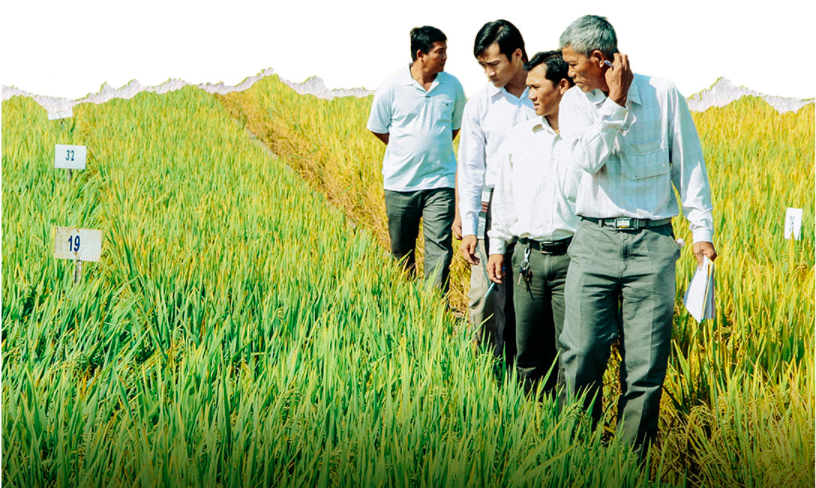 |
| Sample field of Cuu Long (Mekong) Delta Rice Research Institute. Photo: Chi Quoc/Tuoi Tre |
After the 6th National Congress of Communist Party of Vietnam in 1986, Mekong Delta’s farming land increased nearly 100,000 hectares per year. By 2004, paddy fields occupied the total area of some 3.9 million hectares, accounting for 50 percent of the whole country’s rice farming land. Most of these fields produce two to three crops per year.
When the country finally produced the abundance of food, rice no longer played the crucial role of rescuing people from starvation and farmers started switching into farming fish or fruits which offered higher income, Cua set another goal of boosting the quality of Vietnam’s rice.
The journey of creating ST24 and ST25 rice dashed back to 2005 when Cua attended a conference on branding Vietnamese rice in Can Tho City.
“Many scientists, scholars and entrepreneurs gathered to discuss status-quo of Vietnam’s rice industry. Our rice export output has ranked second in the world, exceeding five million tons per year.
But the overall situation was quite pessimistic because prices was still very low due to unstable quality, resulting in poor income and high-risk investments while Vietnamese rice was not well branded,” said Cua.
“Ideas given at the conference were still about using verified rice seeds and developing a specialized rice cultivation area without any mention of crafting a new rice type which could help Vietnam compete with the rice empire Thailand,” he added.
 |
| Vietnam is named among top 3 rice exporters. Photo: Chi Quoc/Tuoi Tre |
Coming back from the conference, Cua met with his colleagues to review what seeds they owned and prepared for the fixed goal of laying a road to the world for Mekong Delta’s premium jasmine rice.
Three years later, in 2008, Cua’s team started creating five new rice types, named them ST21 to ST25 with an acronym standing for Soc Trang.
ST24 was named in the top 3 of global best rice in 2017 and 2018 then ST25 topped the world’s chart in 2019. These types offer fragrant, resilient, delicious and affordable rice.
Packages of ST25 now become a popular gift choice for Tet (Vietnamese Lunar New Year holiday). ST24 and ST25 rice seeds are now grown in not only the Mekong Delta but also the Central Highlands.
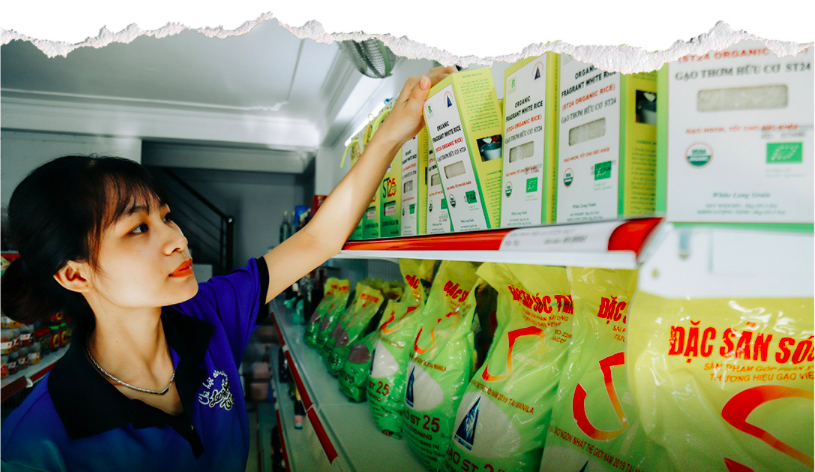 |
| The world’s best rice is on display in Can Tho City. Photo: Chi Quoc/Tuoi Tre |
The world’s best rice
Cua’s journey to find the most delicious rice reflects the journeys of thousands of rice farmers in the Mekong Delta. Vietnam owns the historic process of wet rice civilization yet according to Cua, the favorable weather and soil are really what makes the Mekong Delta the country’s rice bowl.
The government established Cuu Long (Mekong) Delta Rice Research Institute to gather top-tier scientists and engineers to improve the rice and growing methods.
“Three recent tenures of Soc Trang Province’s congresses of CPV prioritized the development of fragrant rice types and premium rice farming areas. These policies have created great momentum to help Vietnamese rice establish reputation,” said Cua.
The Department of Horticulture under the Ministry of Agriculture and Rural Development estimates the Mekong Delta produced more than 24 million tons of rice in 2020 with the average productivity of 6,100kg per hectare. Specialty rice, namely ST20, Nang Hoa 9 and OM, accounts for 15 percent of the delta’s exported output.
“These numbers prove that the Mekong Delta is transforming into the world’s premium rice bowl, focusing on improving quality,” said Professor Vo Cong Thanh of Can Tho University who is also known as “the king of saline intrusion-resilient rice”.
Climate change is the main threat to rice cultivation in the Mekong Delta, according to Thanh.
“At the same time, the government is paying more attention to rice research in an effort to deal with severe climate change impacts. Thanks to the funding of VND5 billion (US$217,000) from the agricultural ministry, we succeeded in restoring the precious indigenous rice of Nang Thom Cho Dao and crafting Mot bui do (a red bush) able to resist saline of 6 to 8 permille,” he said.
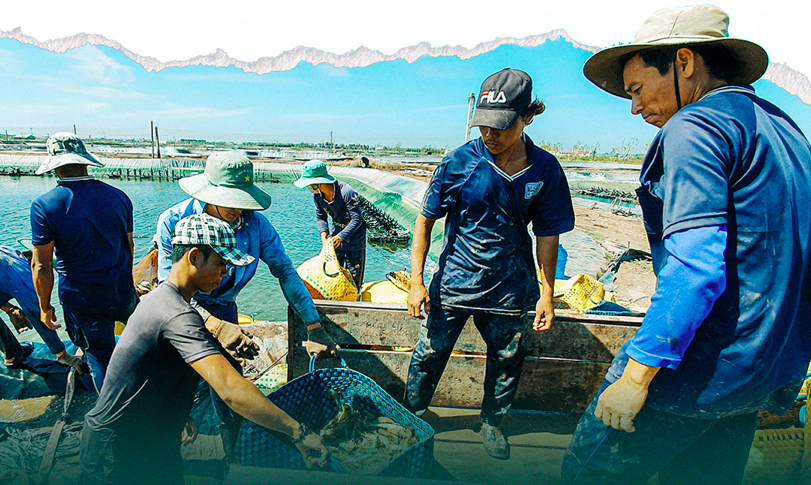 |
| Harvesting white leg shrimps in Soc Trang Province. Photo: Chi Quoc/Tuoi Tre |
Billion-dollar journey of Vietnamese prawns
Ho Quoc Luc, chairman of the managing board of Soc Trang-based Sao Ta Company, was experiencing busiest days in the end of 2020. Against all odds, the company with its some 4,000 workers earned more than $180 million last year.
His story of farming prawns went hand-in-hand with the delta’s coastal area – from a wasted land to one of Vietnam’s biggest “export turnover mines.”
“I started working in this industry in 1983, after Vietnam restarted exporting frozen prawns in 1978. In those years, the highest turnover could only reach some millions of dollars,” said Luc.
Ca Mau Peninsula was Vietnam’s biggest prawn farming area then yet the practice was extensive. Farmers cultured prawns just by seeing and feeling changes of pond water. Prawns were caught every two months and gathered to different food processing warehouses in Mekong Delta for peeling and freezing.
Package of 2kg frozen prawns each were exported to Japan, Hong Kong and other neighbors, according to Luc.
This method of aquaculture was widely applied in other Mekong Delta provinces of Bac Lieu, Soc Trang and Tra Vinh. Export numbers slowly grew yet the industry still lacked a breakthrough.
“It was the early 90s when a farmer initiated to intensively farm prawns, yet the change was only clearly witnessed in 2000, simultaneously, white leg shrimps started being farmed – sending out a positive signal for Vietnam’s aquaculture.
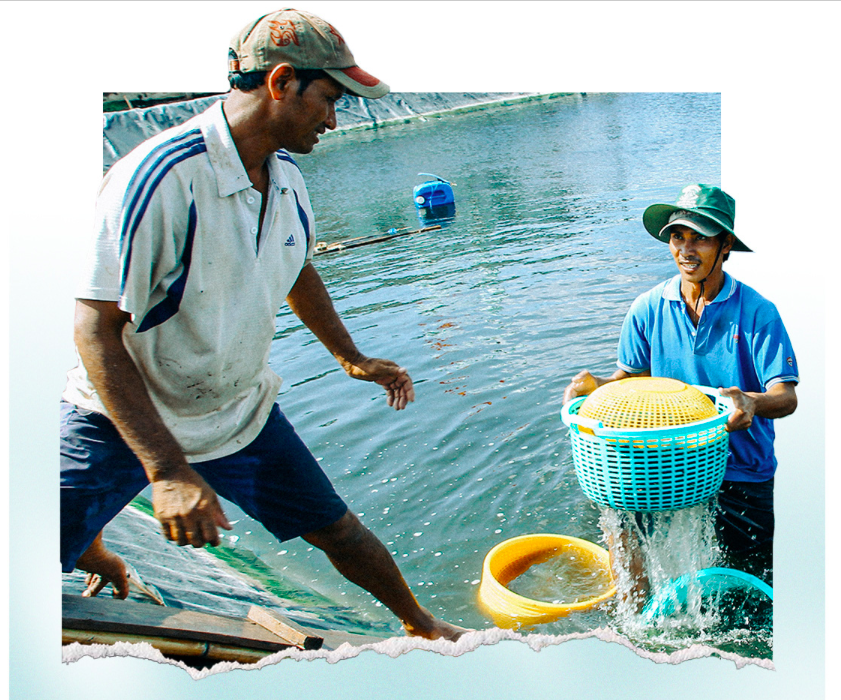 |
| Harvesting white leg shrimps in Bac Lieu Province. Photo: Chi Quoc/Tuoi Tre |
The vanguard, unfortunately, was not successful due to objective reasons – lack of technology and methods among all,” said Luc.
Along with the expansion of shrimp farming ponds, more food processing factories were opened up.
“The industry bloomed, raising the income from exporting prawns to nearly a US$1 billion. In 1995, Vietnam was ranked low among exporters due to simple processing methods and cheap prices. The situation changed completely in 2000 when the country thrived to be top exporting nations, directly competing with Thailand and Indonesia,” said Luc.
The 6th National Congress of the Party created favorable conditions for all economic sectors to participate in the supply chain of frozen prawns, from farming to producing and distributing. The establishment of Vietnam Association of Seafood Exporters and Producers (VASEP) in 1998 helped the industry to take a leap in opening doors to the world market.
“We did not know how to approach new exporting markets, mostly waiting for traders to come. Only when VASEP was established did we proactively seek for buyers, opening up many possibilities,” said Luc.
His most vivid memory of bringing Vietnamese prawns to the world was attached to an international seafood expo in Brussels, Belgium in 1999.
“A delegation of 20 people led by the former Ministry of Aquaculture and VASEP struggled to book a hotel. There was no toilet and we had to take shower in a tiny tub. We did not have a telephone and faxing was charged at $10 for each page. Still, it was the first time ever Vietnamese prawns were branded at the world level,” Luc recalled.
1999 also marked the first time 18 of Vietnam’s prawn companies were provided codes to sell products to the EU market. In four years, from 1999 to 2003, prawn export turnover doubled, from $500 million to $1 billion.
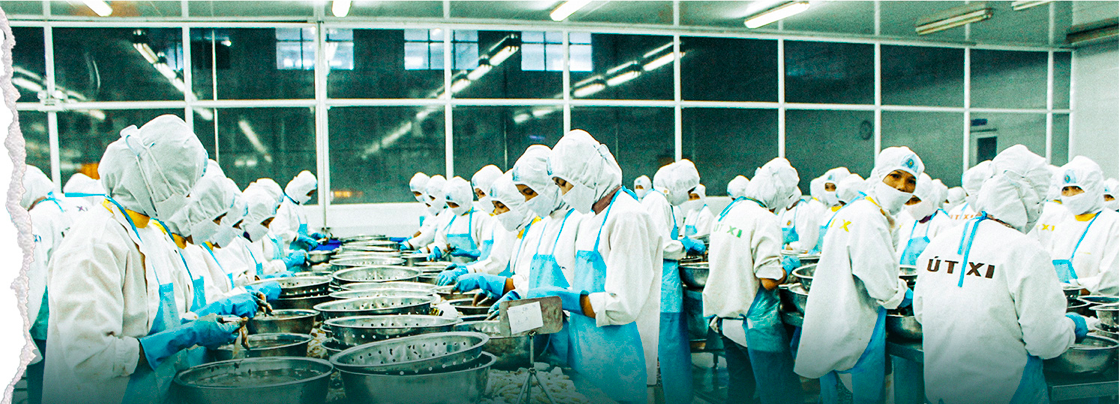 |
| Inside a prawn processing factory in Soc Trang Province. Photo: Chi Quoc/Tuoi Tre |
Overcoming barriers
During this period, the Mekong Delta still lagged behind the southern central region in terms of seeds. While the farming of white leg shrimps boomed in Ninh Thuan Province in the 2000s, farmers in the Mekong Delta kept culturing black tiger prawns as they were scared of diseases which might be spread by the new type of shrimp.
Until 2011 farming white leg shrimps in the Mekong Delta was rare, while accounting for 70 percent of exported products.
According to Luc, the Mekong Delta does not have advantages in farming prawns compared to southern central and northern provinces.
“Water resources are not as good as other regions. However, new methods of processing water and domesticated prawn seeds have been developed. While central provinces are now facing severe pollution due to untreated wastewater from prawn farms, the industry is being accelerated in the Mekong Delta with modern cultivating procedures,” said Luc.
 |
| Harvesting white leg shrimps in Soc Trang Province. Photo: Chi Quoc/Tuoi Tre |
In 2017, as the government identified prawns as the delta’s spearhead and laid out incentives for the industry, the country’s “prawn pond” was preparing for “Industry 4.0.”
Prawn farming turned a new page with huge, high-tech farms, some of which can span the area of 270 hectares.
“The productivity of 10 tons per hectare used to satisfy us. Now the goal is much higher,” said Luc.
Everything changes. They now prefer smaller ponds to easily control pond beds.
Technology is applied to automatically feed prawns, track indicators of saline, pH and mineral, operate shading systems and harvest.
Thanks to these innovations, despites turbulence caused by COVID-19, the prawn exporting sectors earned $3.8 billion in 2020, compared to $3.3 billion in 2019.
 |
| Inside a large-scale prawn farming in Soc Trang Province. Photo: Chi Quoc/Tuoi Tre |
Cross the sea
In 1987, Vietnamese catfish took the first step to the world’s market, becoming one of the country’s signature products.
A monument of a basa fish was built in 2004 in Chau Doc Town, An Giang Province – home of the industry. Nguyen Minh Nhi, former head of the provincial People’s Committee, was the person who brought An Giang in becoming the home of catfish in Vietnam.
Vietnamese people returning from Cambodia took lead in farming fish in rafts.
“Among all types of fish, there were basa fish, commonly known as ‘belly fish’ due to their fatty bellies,” said Nhi.
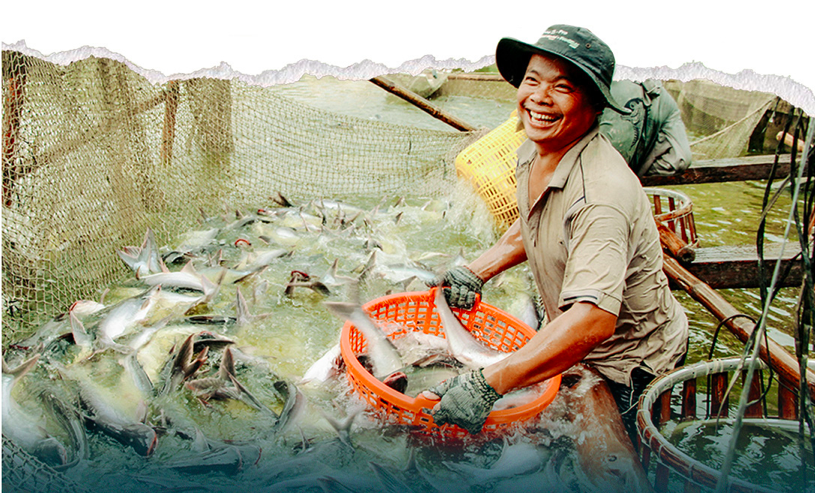 |
| Catfish farmers in Mekong Delta still experience ups and downs as the sector develops unattainably. Photo: Chi Quoc/Tuoi Tre |
At first, fish farming was simply to nurture fish fingerlings in bamboo rafts. More and more rafts appeared on Hau River – a branch of Mekong.
Mature fish were brought for sale at wholesale markets along the river. Basa fish became more popular in local cuisine.
“Nguyen Thanh Hung also known as Muoi Hung, director of Sai Gon Frozen Food Factory No. 1, thought basa fish tasted good, easy to cook and suitable for Australian appetites then introduced it to Australian food distributors. They loved it at first sight. In 1987, when An Giang had its first food processing factory under Seafood Import-Export Company, Hung helped to connect with Australian partners to bring basa fish fillets to Australia,” Nhi recalled.
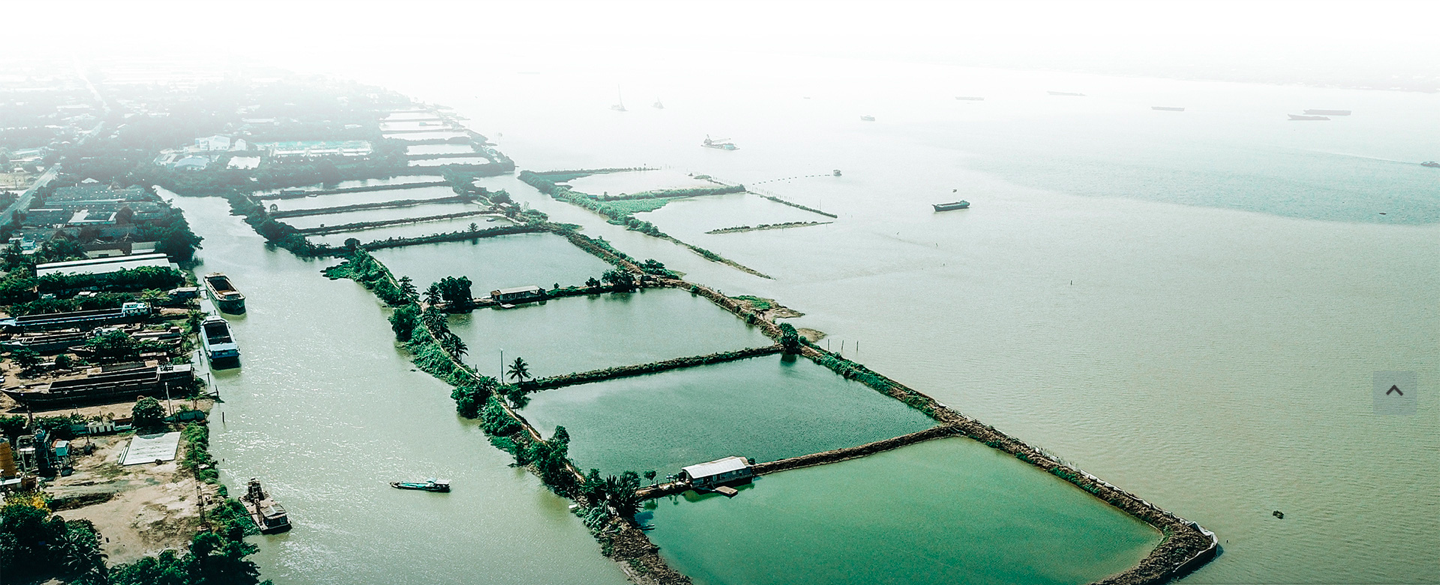 |
| Basa fish farming on the Hau River. Photo: Chi Quoc/Tuoi Tre |
Going across the ocean, two tons of basa fish fillet samples rapidly won over Australian customers. More and more orders were sent back to Vietnam. In 1988, Muoi Hung played big by investing 300 ounces of gold to build 10 wooden rafts on the Hau River in collaboration with a company in Chau Doc Town.
The industry of farming basa fish for export was then officially established in Vietnam with new markets unfolded. Basa fish from the Hau River appear on dining tables in different countries.
To meet the high demand of basa fish in the 90s, food processing companies switched to catfish which are much more resilient than basa fish and sold at cheaper prices.
Fishing vanguard
Ten provinces of the Mekong Delta have more than 7,000 hectares of catfish farming with the output of millions of tonnes.
“To have enough fish fingerlings, scientists of Can Tho University went to Laos to study the characteristics of catfish and the food it prefers. It was a process of trials and errors,” Nhi concluded.
July 20, 1995 was an unforgettable day when 5,000 basa fish fingerlings were bred at Can Tho University’s lab with the assistance of French scientists.
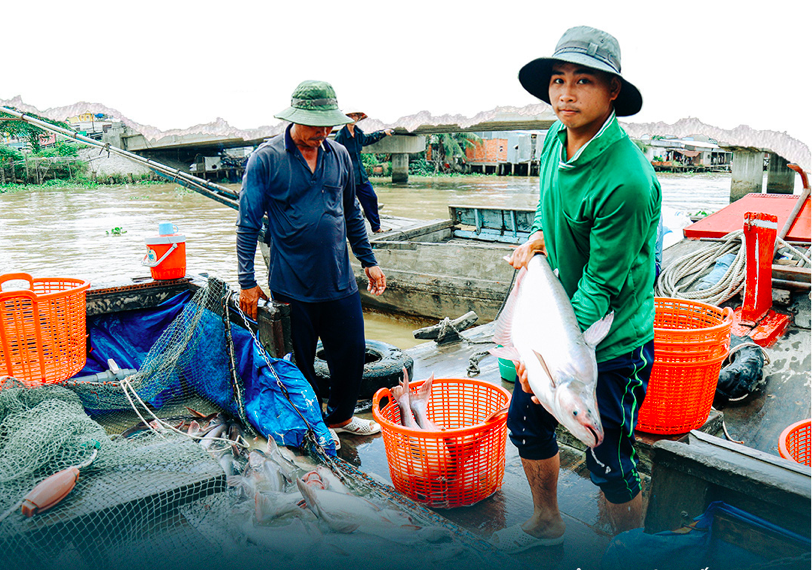 |
| Trading catfish in Vinh Long Province. Photo: Chi Quoc/Tuoi Tre |
The research was duplicated on catfish. The result turned out satisfying as catfish artificially reproduced much more strongly than basa fish.
Ten years later, the area of catfish farming in Mekong Delta expanded to nearly 5,000 hectares, driving Vietnam to the world’s leading country in processing and exporting catfish. Besides fillets, catfish and basa fish are used to produce collagen, gelatin, anti-aging supplements and animal feed.
Despite competing with other seafood exporting countries, India, Indonesia and China among all, Vietnam still takes lead in terms of quantity. Catfish export reached its peak in 2018 with 1.36 million tones, accounting for 45 percent of the global output. Catfish’s export turnover touched the benchmark of $2 billion in 2018 and 2019, making up 25 percent of the seafood sector’s export turnover.
 |
| Basa fish monument in Chau Doc Town An Giang Province. Photo: Chi Quoc/Tuoi Tre |
Fruits go, money back
Fruits bring Vietnam billions of dollars per year while the Mekong Delta – home of 34 percent of the country’s fruit gardens – contributes the largest part. More importantly, it has changed the landscape of fruit farming over the years.
The Southern Horticultural Research Institute (SOFRI) plays a crucial part in boosting the sector.
“Without late Prime Minister Vo Van Kiet’s vision, Vietnam’s fruit sector would have hardly gained today’s success,” said Nguyen Minh Chau – one of the country’s leading horticultural scientists.
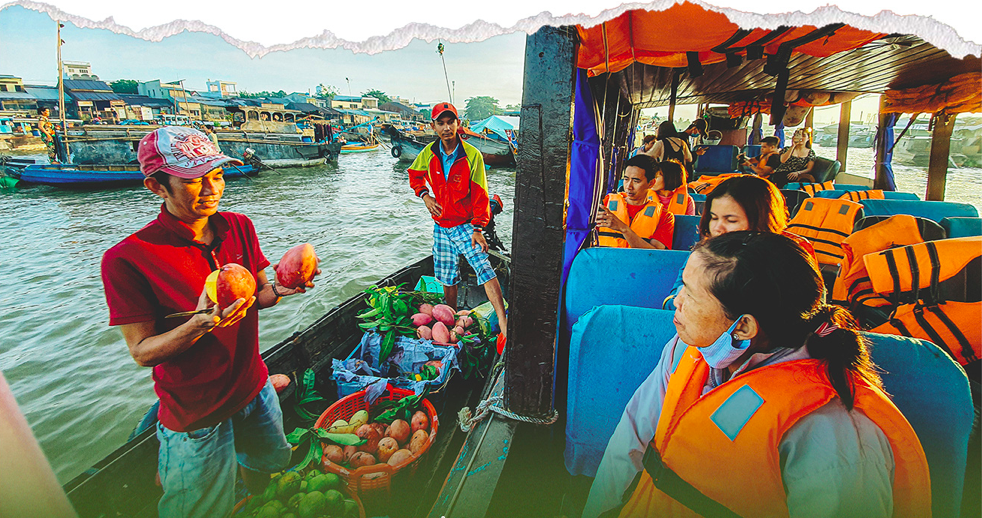 |
| Tourists visit Cai Rang Floating Market and buy fruits. Photo: Chi Quoc/Tuoi Tre |
Chau wanted to refer to Kiet’s approval of establishing Long Dinh Fruit Center in 1994 then upgraded it to SOFRI in 1997.
Chau was the institute’s first chairman.
“Earlier, Vietnam only exported fruits produced by cooperatives to Soviet Union or sold at fresh markets. Can Tho University bore the main responsibility in conducting research on fruits. Their significant works focused on managing the blooming of mango and durian,” said Chau.
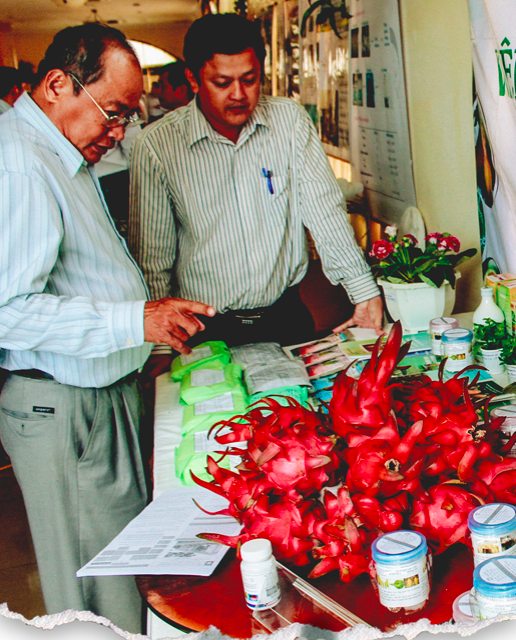 |
| Dragonfruits by SOFRI are showcased at an international fair. Photo: Chi Quoc/Tuoi Tre |
However, Mekong Delta was still a no-name player in the industry. The establishment of SOFRI marked a milestone and set clear goals to make fruits a spearhead to Vietnam’s agriculture.
Thanks to the normalization of Vietnam-U.S. diplomatic relations, Chau was able to send his officers to India, Taiwan, Thailand, France, New Zealand, the U.S. and Australia to join capacity training and approach models to develop the sector.
“SOFRI was established amid the citrus greening disease. We collaborated with a French organization to find solutions. Mekong Delta was then the first area to control the epidemic by managing psyllids which transmit the disease.
“We were supported by former agriculture minister Nguyen Cong Tan to collaborate with foreign countries. Prime Ministers Nguyen Van Khai and Nguyen Tan Dung paid visits to the institute. Their gestures created great momentum for us to continue this path,” said Chau.
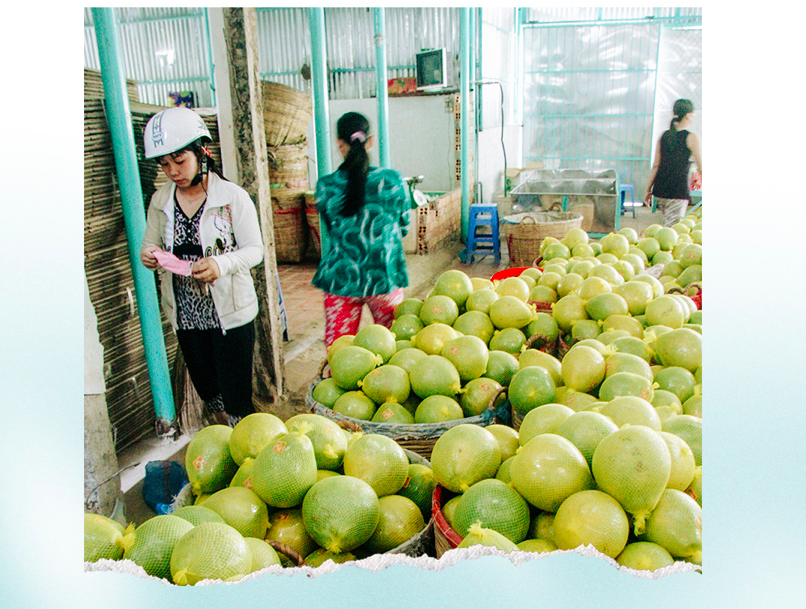 |
| Green skin pomelo is Mekong Delta’s spearhead fruit. Photo: Chi Quoc/Tuoi Tre |
Winning over difficult markets
Besides research, SOFRI builds a roadmap for Vietnam’s fruit industry.
“To sustainably develop, it is critical to have good seeds. We hosted a competition to find the best seed in April 1996 with hundreds of local fruit gardens as participants,” said Chau.
“It was fierce. Mango, taken alone, had a dozen varieties. However, when judges tasted Hoa Loc mangoes, they all agreed that type was the best,” he recalled.
Many similar competitions took place later, attracting more participants and bringing to light specialties of Chin Hoa durian, Mo Cay green-skin pomelo from Ben Tre Province or Tan Quy mangosteen from Tra Vinh Province.
However, it took another decade to build a strong branding for fruits grown in Vietnam. In 2005, when a group of American experts came training their Vietnamese counterparts on standards of GLOBALGAP or EUREGAP, Chau thought the mission would be “impossible”.
“Yet in 2006, Vietnam had a standardized garden growing dragon fruits to export to Japan. Hoa Loc mango, Nam Roi pomelo, rambutan and longan were also delivered to the world, opening a new chapter for Vietnamese fruits. It’s not about governmental incentives, it’s also farmers’ capacity,” said Chau.
With the support of SOFRI, the Mekong Delta formed source areas for specialties. The institute helped to craft new varieties of fruits including red flesh dragon fruits or seedless honey oranges, helping the local horticultural sector to take a giant leap to earn billions of dollars in such a short period of time.
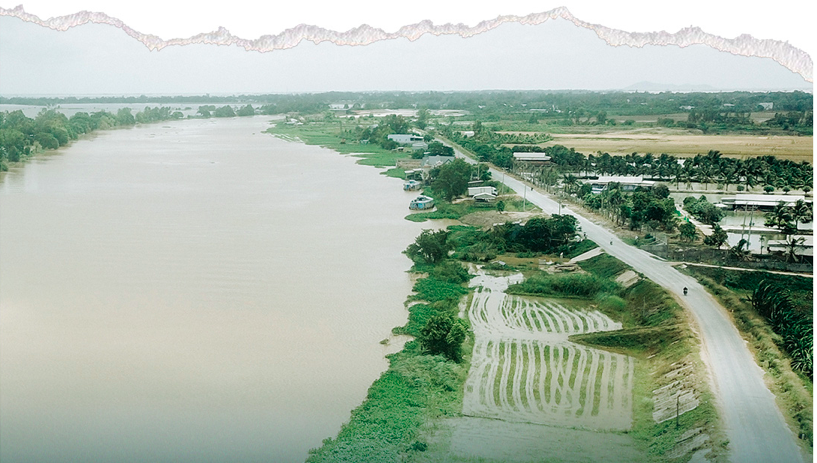 |
| A canal leading freshwater to An Giang Province’s farms. Photo: Chi Quoc/Tuoi Tre |
From wasted land to prosperous paddy fields
If the Bao Dinh River connecting Long An Province’s Tan An City with Tien Giang Province’s My Tho City or the Thoai Canal running through An Giang Province’s Long Xuyen City to Kien Giang Province’s Rach Gia City which were dug during the Nguyen Dynasty to symbolize the land reclamation period, forming today’s Mekong Delta, history might also recognize following explorations in the 80s and 90s which turned wasted land to prosperous areas.
To people of Mekong Delta, the exploration of Dong Thap Muoi (Plain of Reeds) and the canal system of T4-T5-T6 connecting provinces of An Giang and Kien Giang are two essential constructions to accelerate the local economy.
Farmer Nguyen Van Thanh in Tan Hung District, Long An Province was one of explorers. He still owns more than 60 hectares of paddy field – the achievement of this great reclamation.
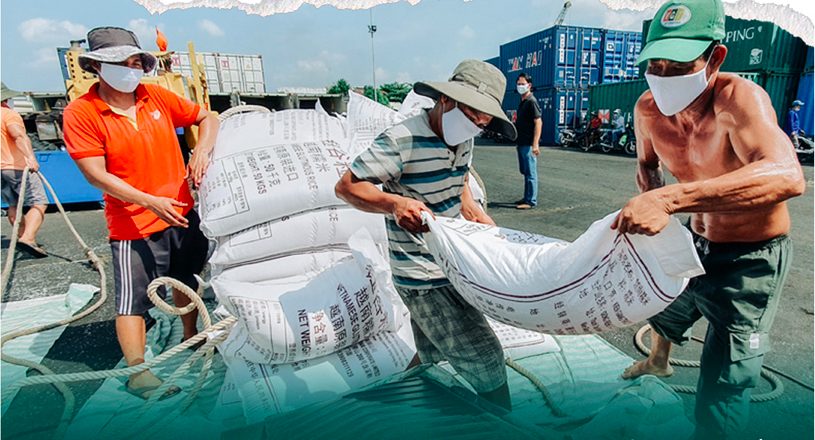 |
| Containers of rice are docked at An Giang Province, waiting to deliver Vietnamese rice to foreign countries. Photo: Chi Quoc/Tuoi Tre |
After the country’s reunification, Thanh left his hometown in Hong Ngu District, Dong Thap Province to carve out his career. Dong Thap Muoi – the intersection among provinces of Long An, Dong Thap and Tien Giang – was immersed during the flood season. When flood water receded, the land was covered in grass. People entered the area by going along river branches, burned grass and waited for floods to receive freshwater in an effort to grow a crop.
“If we got lucky, we would harvest two tons of rice per ha. Normally, we received nothing and lived upon fishing.
The construction of the Central Canal changed everything. We now can plant up to three crops per year and get up to 10 tons of rice per crop,” said Thanh.
In seven years, from 1977 to 1984, the Central Canal was a collective effort of thousands of people digging days and nights to bring freshwater to the plain and wash away alum.
Late Prime Minister Vo Van Kiet paid several visits to encourage people to continue the work, despite the doubt that the canal might destroy Dong Thap Muoi.
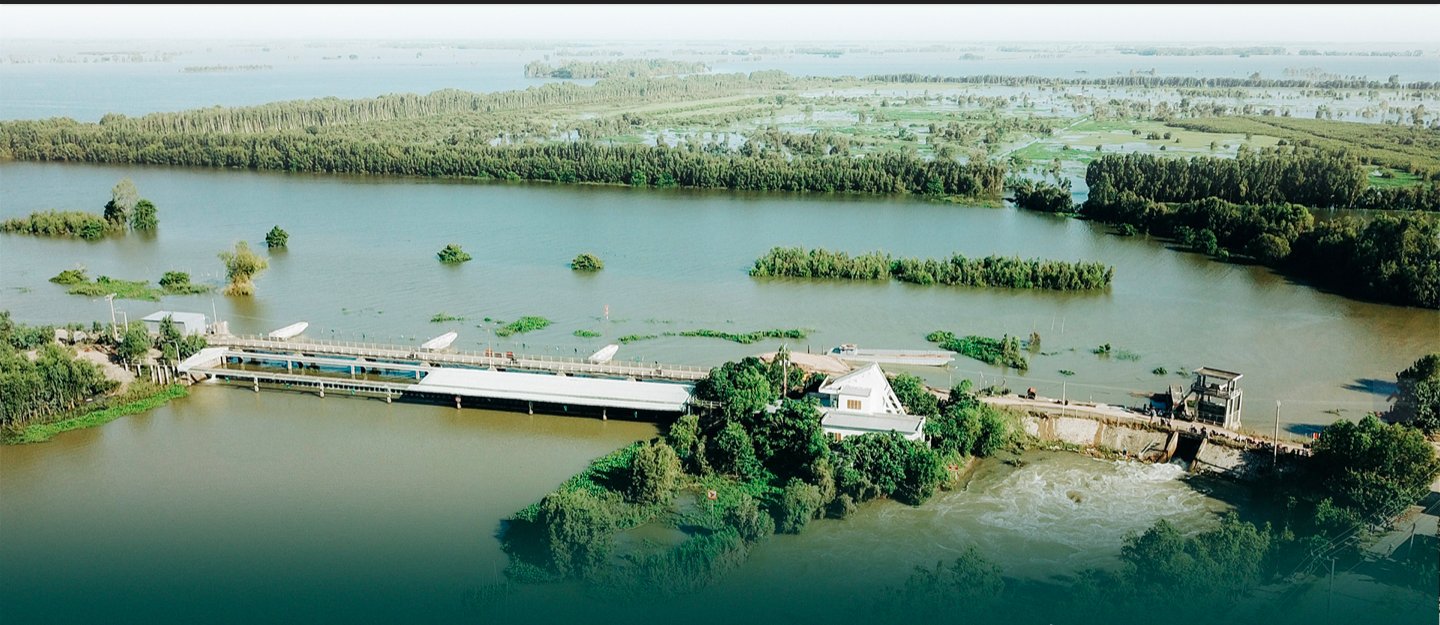 |
| A part of the Long Xuyen Quadrilateral Region seen from An Giang Province. Photo: Chi Quoc/Tuoi Tre |
Canals that change everything
Long Xuyen Quadrilateral Region, conversely, was in an urge to drain constant flood water from Cambodia.
Nguyen Minh Nhi, former head of An Giang Province People’s Committee, never forgets the strong objection from the Cambodian side when they discussed building a canal to connect two neighboring provinces.
“They were afraid that the canal would make their province more vulnerable to floods and alum-contaminated,” he said.
“Late Prime Minister Vo Van Kiet who was knowledgeable about the delta’s natural conditions intervened to make it happen,” Nhi added.
T5 canal which spans over 48km was constructed over four months, starting from April 1997 in Tri Ton District, An Giang Province. Thanks to the canal, thousands of hectares of land from An Giang to Kien Giang became prosperous paddy fields and livable towns as we see today.
The canal was later named after late PM Vo Van Kiet.
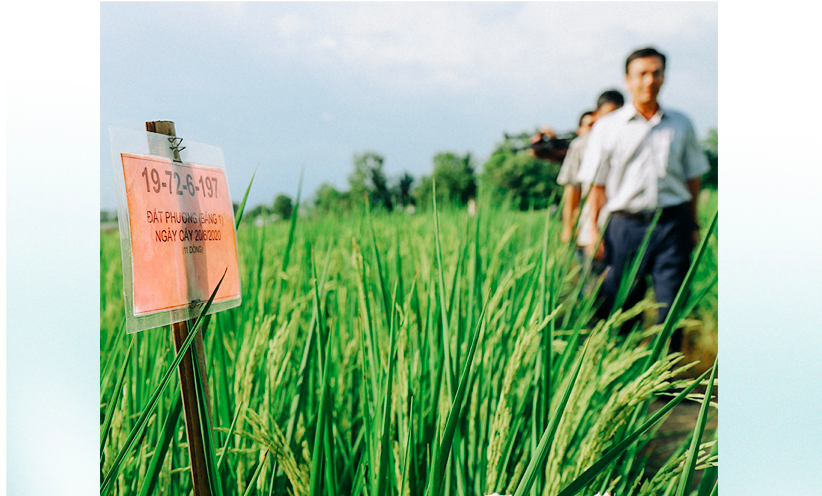 |
| A field for crafting sample seeds seen in Ca Mau Province. Photo: Chi Quoc/Tuoi Tre |
Escaping the vicious circle
When the sediments of the Mekong River ran through the canals to the delta, farmers easily yielded good rice crops, it was the time when the old buying market was gradually broken. They were caught in the vicious circle of high productivity but poor prices.
To save farmers from the trap, large-scale rice fields were initiated to help connect enterprises and farmers.
“The large-scale field is the perfect model which links farmers, businesses, government and scientists,” said Duong Van Chin, former deputy head of Cuu Long (Mekong) Delta Rice Research Institute.
According to Chin, by participating in the model, farmers would be secured that their products would be bought by companies while companies would reserve resources to satisfy demands.
“Since the introduction of large-scale fields, technological advances have been effectively applied to the agricultural sector,” said Luu Hoang Ly, director of Bac Lieu’s Department of Agricultural and Rural Development.
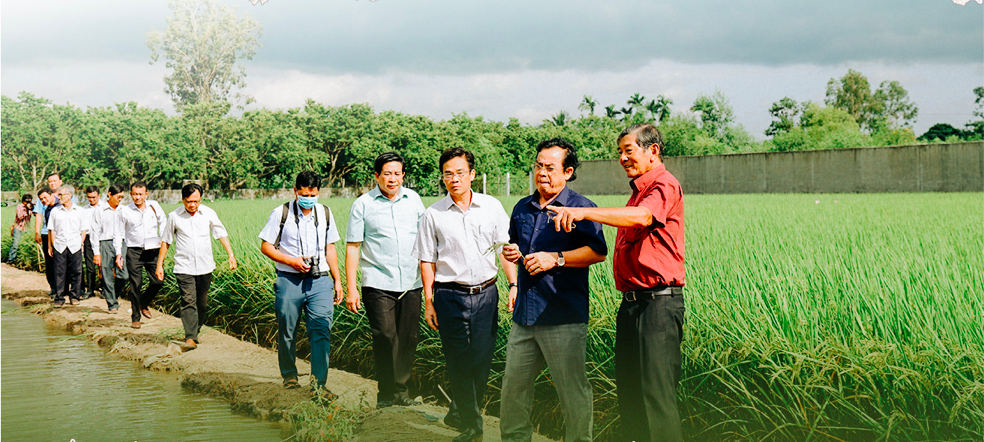 |
| Ho Quang Cua (red shirt) introduces Bac Lieu Province’s officials to his ST24 and ST25 rice in his field in Soc Trang Province. Photo: Chi Quoc/Tuoi Tre |
Local farmers are getting familiar with using lasers to ground paddy fields or flying drones to spray pesticides.
Besides improving productivity, these innovations help to drive Vietnam’s agriculture forward on a more sustainable path.
Large-scale fields are no longer exclusive to rice crops but also to fruit planting areas.
Vo Quan Huy opened the door for Vietnamese bananas to enter Japan’s market in 2016 said without the big supply chain, it would be impossible to ensure quality and persuade picky markets.
Under Huy’s banana brand FOHLA, all processes are synced, from creating seeds to setting up warehouses and automatic zip lines to deliver bananas directly from gardens to processing rooms.
“It will be impossible if our scale is too small. Developed markets of Japan, the U.S. or EU require very high standards and close monitoring from planting to packaging,” said Huy.
To meet these strict requirements, new cooperatives have been formed to have representatives do negotiations with traders. Huy, however, chooses to collaborate with banana farmers.
The initial investment is made by both farmers and the company. Meanwhile, FOHLA will be in charge of standards, techniques and procedures.
The landowner will take care of the labor part, included in the investment amount. When harvested, all bananas will be purchased by Huy at the prices signed from the beginning. The profit afterward will be split by half again.
The model is applauded by farmers with more than 200 hectares of bananas planted last year in provinces of Long An, Tay Ninh and Dong Nai.
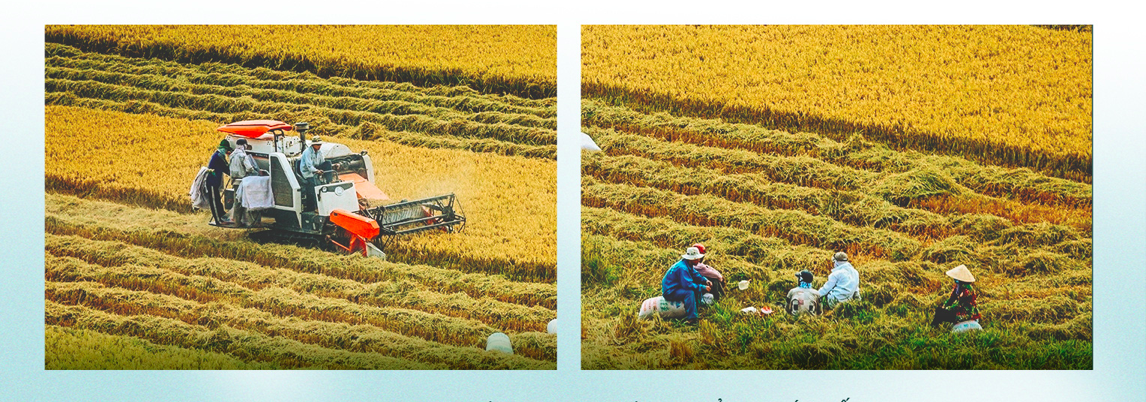 |
| Harvesting rice in a large-scale field in Can Tho City. Photo: Chi Quoc/Tuoi Tre |
Like us on Facebook or follow us on Twitter to get the latest news about Vietnam!

